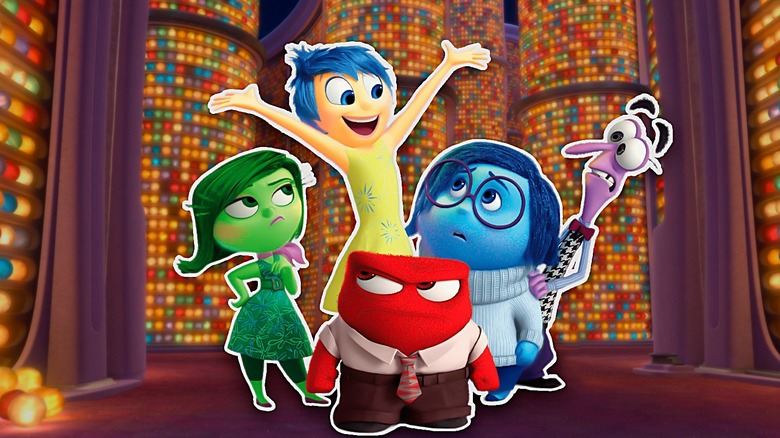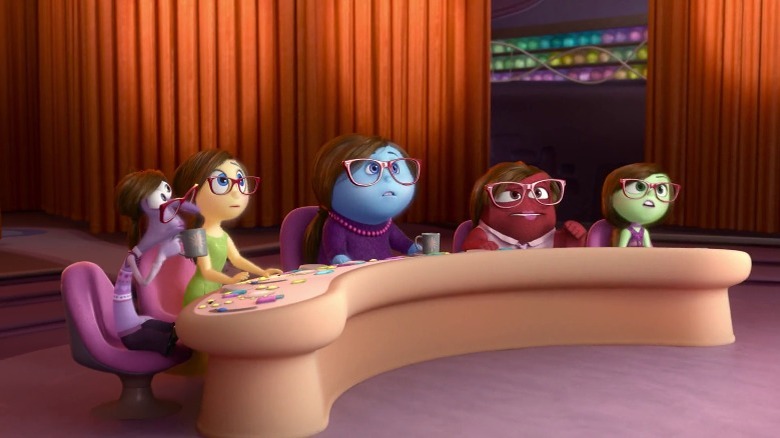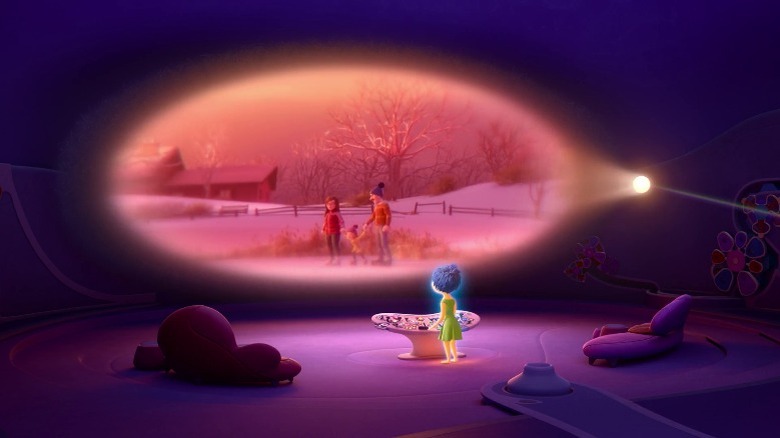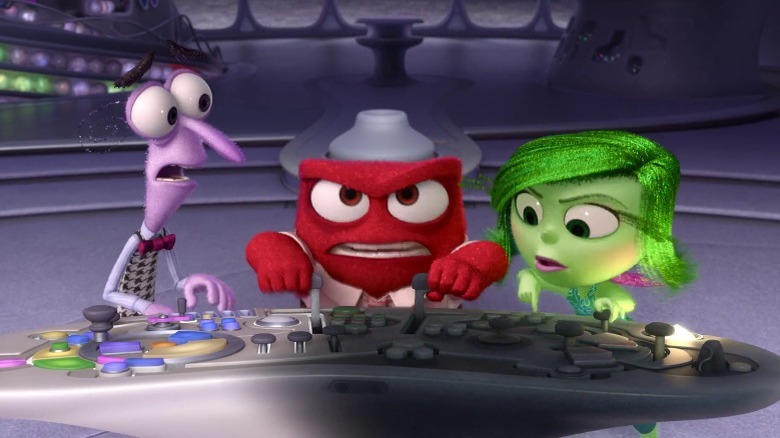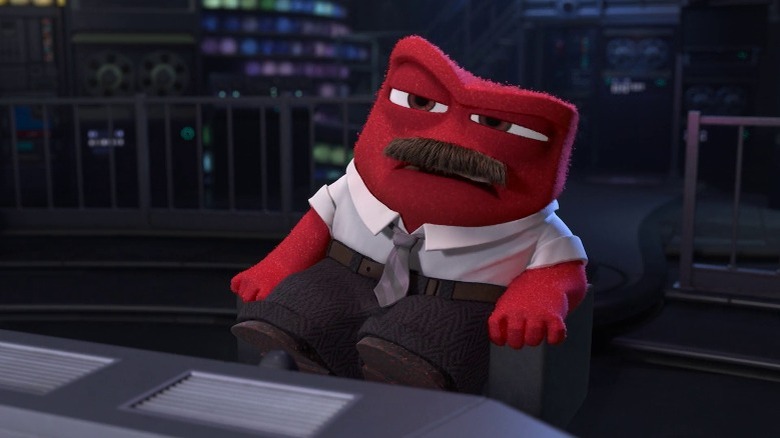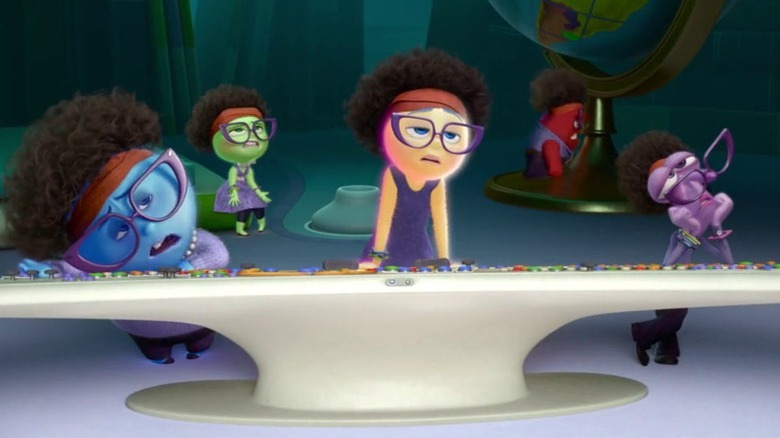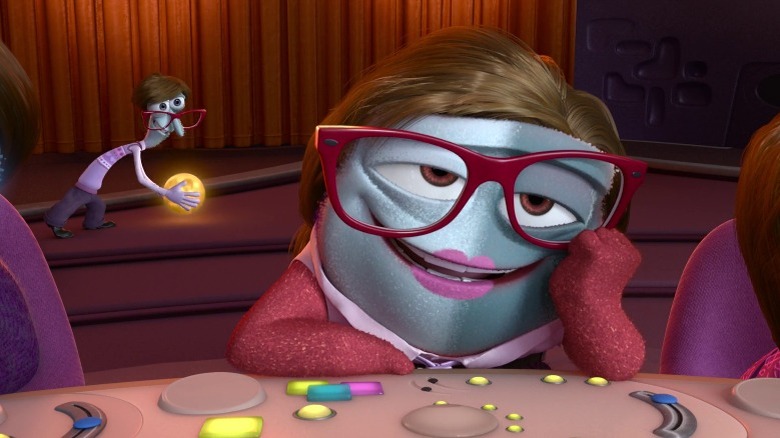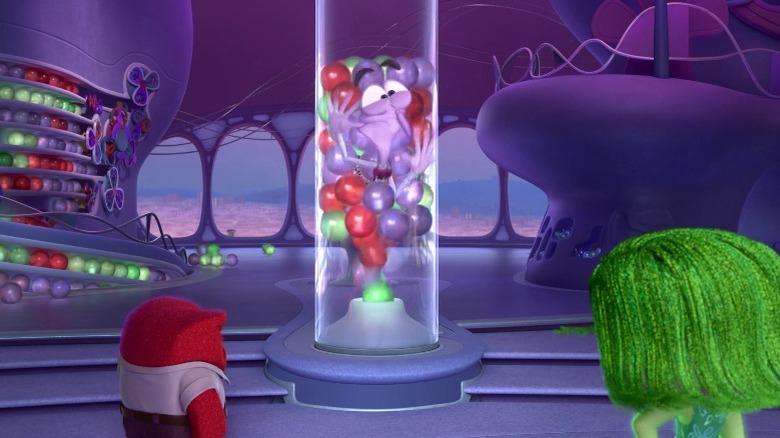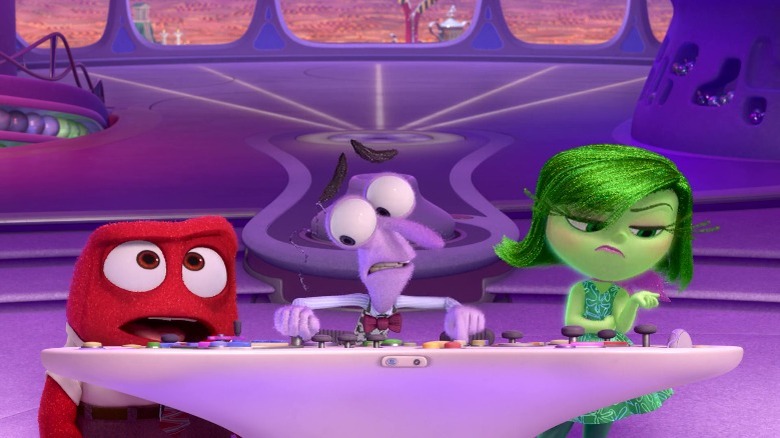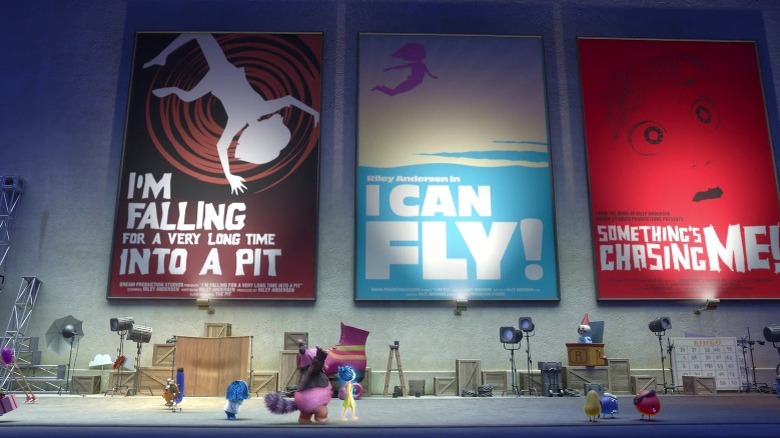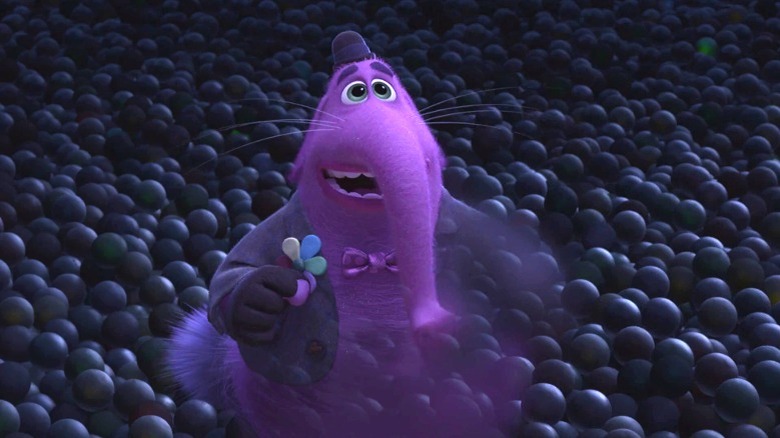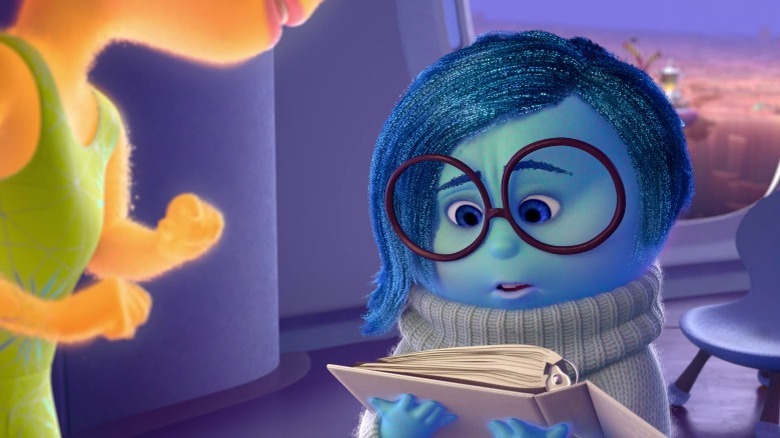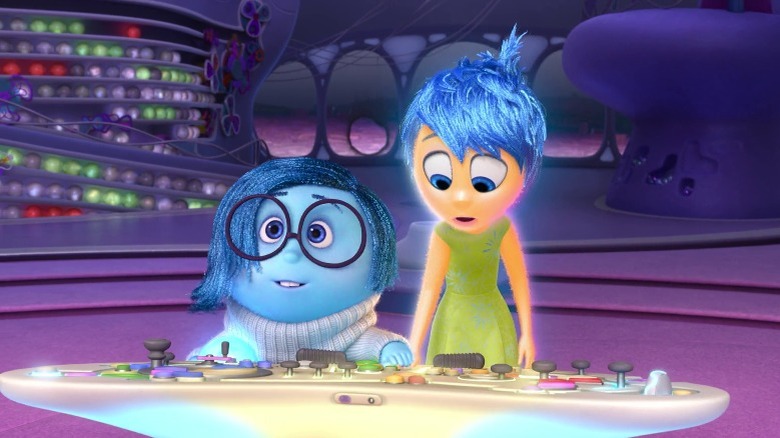Things Only Adults Notice In Inside Out
The last few years have been a rollercoaster for Pixar Animation Studios. Between parent company disdain, critical ambivalence, box office struggles, and competition from rivals such as Sony Pictures Animation, it seems like the studio is having trouble navigating this new landscape. Where they used to produce masterpieces year after year, we're now going on nearly a decade without an unambiguously, inarguably classic original Pixar film.
Still, the fact that the last unambiguous classic in question was "Inside Out" is reason enough to remember that Pixar can never be counted out. Like the best Pixar films, it makes greatness look casual, to the point where we forget what a wild, bold swing it was because of how effortlessly it endeared itself to worldwide audiences. Unlike other excessively extended brands in the studio's catalog — such as the "Cars" franchise — "Inside Out" is a film that lends itself effortlessly to new stories. This makes the prospect of a sequel genuinely exciting.
Let's take a closer look at all the details in "Inside Out" that make it such an enduring film not just for kids, but also for adults. Here are some of the things that you might only pick up on if your Headquarters had gotten the adult upgrade.
Emotions operate differently in grown-ups
"Inside Out" is centered on the mind of a child, and it tackles the emotional disarray that characterizes that period of life. But the film also takes the time to hop into the heads of the other people around Riley (Kaitlyn Dias), such as her parents. When we get a glimpse into their Headquarters, some interesting things are revealed about the way maturity affects the mind.
In the minds of both Riley's mother (Diane Lane) and father (Kyle MacLachlan), the emotions operate as a much more cohesive and coordinated team, sitting together around a larger control panel that every emotion has access to. The emotions work in tandem, with each one contributing a little to any given situation — in sharp contrast to the incessant scramble for control going on inside Riley's head.
Even the emotions themselves are shown to be more level-headed in the adults' heads. While their equivalents in Riley's mind are shown to be driven by their representative emotions most of the time, the "workers" in her parents' Headquarters are depicted more like professionals with specific tasks and agendas. This doesn't mean that the adults aren't prone to irrationality and impulsive emotional outbursts, but they've learned to manage those impulses over time.
Joy keeps Riley stuck in nostalgia
The main message of "Inside Out," is that all emotions have their place and are important to a person's development, including Sadness (Phyllis Smith). But what a more seasoned viewer might also notice is that the film goes beyond that important yet simple message, and into more incisive thematic territory in the way that it analyzes the role of Joy (Amy Poehler) in Riley's mind.
Joy is undeniably at fault for suppressing Riley's more negative and nuanced emotions and futilely attempting to keep her happy 100% of the time — that much is evident. But pay closer attention to the character's actions and their consequences in the film, specifically the way that Joy keeps desperately replaying Riley's old happy memories when she's reacting to the move to San Francisco. Because it's difficult for Riley to find things to be happy about in her new situation, her mind keeps clinging to old, bygone sources of joy. But those memories can't do anything for Riley in the present except remind her that things are not the way she wants. In clinging to them, she is unable to process her current situation, and, in refusing to process it, she forfeits hope of forming any new happy memories, which is what would make her new life more bearable.
The film's metaphor for depression is deeply thought-through
The most tear-jerking moment in the movie comes when Sadness takes over Riley's Headquarters just as she's returning home to her parents, resulting in a long-overdue emotional breakdown that finally allows them to understand the pain she's in. The fact that Riley's control panel was turning gray and inoperable before that moment has been widely interpreted as a metaphor for depression, which Riley is only able to break out of when she accepts and surrenders to the sadness her mind has been frantically attempting to suppress. It's an incredibly potent insight — but the film's depression metaphor runs even deeper than that.
Essentially, Riley's depression is a result of dysfunctional emotional processing. Her mind cannot deal with all the feelings that moving to San Francisco stirs in her at once. She may have been a very happy kid before, but her happiness, her sense of self, and her relationship with life were all contingent on external circumstances that no longer exist. Never before had she been cast so helplessly into a situation that left her so vulnerable to fear, rage, repulsion, and confusion. As a result, she shuts down emotionally, because her mind doesn't know what else to do. It's only by accepting and moving through the pain — with the help of Sadness — that she's able to break out of that defensive apathy and feel again.
Mom and dad's Headquarters are not ruled by Joy
In the case of a child, the question of which emotion is dominant in Headquarters proves to be much more crucial, since only one emotion can operate the controls at a time. Indeed, it's Joy's autocratic central role that eventually makes everything fall apart. In adults, meanwhile, it appears that there is a "central" emotion at Headquarters — but it's more of a team coordinator, making sure everybody's actions are aligned. It's never confirmed if the emotion sitting at the center of an adult control panel is constant or changes from moment to moment as the situation dictates, but, whatever the case, the emotions seen exercising leadership in Riley's parents are very revealing.
In her mother's mind, the leader is Sadness — which makes perfect sense for an adult who is currently experiencing a melancholy life change, and constantly fretting over her family's emotional wellbeing. Sadness is, after all, the emotion that powers empathy. Riley's father, meanwhile, is having his emotions coordinated by Anger, which is also a very understandable adult response to the series of setbacks and logistical issues he's having to deal with at home and work during the movie.
Every character's leading emotion reflects their personality
The significance of the leading emotions in the characters' minds doesn't stop at Riley and her parents. In the credits, we get to have a look at the Headquarters of other minor characters in the film, and each one reveals something amusing about the character in question.
Riley's school teacher (Dawnn Lewis), depicted in a bout of frustrated boredom at her students' disinterest in her class, is shown to be led by Joy. This may seem counterintuitive at first, but it makes sense: Remaining cheerful and attuned to the world's wonder and the fun of exploring it, even while thinking about an upcoming summer getaway, is an indispensable tool in a middle school teacher's arsenal.
The perpetually annoyed cashier at the pizza place is managed by Disgust, which tracks with her dry attitude towards her customers. Since Disgust is the emotion of social and aesthetic judgment, it's also no surprise that someone who has to deal with customers all day would default to being led by it. The cool girl at Riley's school is, of course, ruled by the constant Fear she has of being exposed as a fraud. We even get a glimpse into the real-life Jangles the Clown (Josh Cooley), who, despite his hatred of his job, is ruled by Joy — a nice rhyme with the schoolteacher, as two adults whose professional lives revolve around keeping kids entertained and engaged.
Anger and Fear come into play just as they do in real life
As previously mentioned, Anger is the emotion that oversees Riley's father's Headquarters. But what's even more interesting is the fact that Fear appears to be Anger's second-in-command, keeping him informed and co-signing his decisions — which leads to poor parenting during the dinner argument scene. This makes perfect sense, as the stress Riley's father is experiencing during the move is ultimately a result of his fear for the well-being of his family. Just like in real life, Fear and Anger interact to deal with situations perceived as threatening, and the decisions they produce might leave something to be desired in terms of empathy and delicacy.
In Riley's mother, meanwhile, Fear and Anger don't play such a central decision-making role, but their behavior is still fascinating. When things go south during the argument scene, it's the mother's Anger that remembers the handsome Brazilian helicopter pilot and calls up the memory of him. It seems that momentarily fantasizing about what could have been is a useful escape valve when Riley's mother gets mad at her husband. Then, at the end of the film, Anger throws away the memory of the pilot — but Fear awkwardly runs to fetch it, "just in case." When the present is unsatisfying, Anger compares it to the past, but when it's valued, it becomes something that can be lost, so Fear keeps nurturing the comparison.
Fear can't leave his post even if he wants to
With Joy and Sadness lost somewhere in the recesses of Riley's mind, it's up to Fear (Bill Hader), Disgust (Mindy Kaling), and Anger (Lewis Black) to run Headquarters in their absence. At one point, Fear gives up trying to salvage Riley's emotional state, and attempts to quit, leaving Headquarters through the same tube that sucked up Joy and Sadness. But the tube rejects him and throws him back, prompting Disgust to note, "Emotions can't quit, genius."
The emotions can't quit, but Joy and Sadness were very much removed from Headquarters, which was functionally identical to what Fear tried to do. This seems to suggest two things. The first is that, while emotions being accidentally ejected during an emotional struggle is something that can happen, an emotion can't voluntarily self-eject. Our feelings might get messy and incomplete for any number of reasons, but we're not allowed to choose ones to get rid of.
The second is that Fear can't remove itself from our minds out of, well, fear. There's an argument to be made that fear is the most primal of all human emotions — the base instinct to evade danger and keep oneself alive and healthy. We can block out our sadness, our anger, and even our joy, but fear is not something that can be suppressed; it's always there to some degree, an omnipresent participant in decision-making processes.
That one San Francisco joke
"Inside Out" may be a kids' movie, but it's also a Pixar movie, and, as such, there was no way it would pass up the opportunity to make at least a couple of adult-oriented jokes about San Francisco where the film is set. The maddening traffic, the young apathetic cashier with a purple sidecut, and the broccoli pizza are the obvious ones. But the funniest joke is arguably the one that's most expressly designed to go over kids' heads and make their parents laugh.
We're referring, of course, to the bear joke, in which the noise of a loud vehicle makes Fear wonder "What was that? Was it a bear?" In response, Disgust says, "There are no bears in San Francisco," prompting Anger to remark "I saw a really hairy guy. He looked like a bear."
To some extent, "a guy so hairy he looked like a bear" is technically descriptive enough to work as a joke even if you're unfamiliar with a certain terminology. But what's funny about the joke is the reference to the San Francisco LGBTQ+ community, and specifically to the concept of "bears" — which is gay slang for plus-sized, hairy guys. If you're an adult who's aware of the city's status as a worldwide queer capital, the phrase "There are no bears in San Francisco" alone is enough to make you start giggling.
The film makes plenty of adult cultural references
There are several references in "Inside Out" that children would be very unlikely to get. Heck, some of the references are specific enough that even the average adult viewer might not pick up on them at first.
The most memorable one is arguably the "Chinatown" shout-out. While two security guards are trying to solve the case of the cloud man who was blown away by Bing Bong (Richard Kind), Joy dashes right through the cloud man's wife as she's giving testimony. This systemic failure of justice prompts one of the officers to take off his sunglasses and say, "Forget it, Jake, it's Cloud Town" — a hilariously over-the-top nod to the bleak ending of the classic 1974 detective film.
When Joy, Sadness, and Bing Bong are walking through the Dream Productions lot, one of the posters they pass by, for a film titled "I'm Falling for a Very Long Time Into a Pit," is a clear parody of Saul Bass' iconic poster for "Vertigo" — a 1958 film in which James Stewart's character has a nightmare about just that. It's a bit more of a stretch, but you could also argue that Riley's mother's Headquarters is designed to mimic the set of "The View," complete with coffee mugs.
When Riley forgets Bing Bong, so does the movie
It tends to be the case that, when a major character in a movie has a big, tear-jerking death scene like the one Bing Bong has in "Inside Out," the movie will later take at least a moment to memorialize or mourn that character in some way. In this film, conversely, the characters don't even acknowledge Bing Bong after he sacrifices himself to allow Joy to escape the Memory Dump. When he's forgotten by Riley and fades away, it seems like the movie forgets about him as well.
It's a decision that may feel odd and unsatisfying, especially for younger viewers, all the more so given how abrupt and definite his death feels. But adult viewers understand exactly why the movie depicts Bing Bong's demise that way. The very source of the melancholy underlying Bing Bong as a character is the fact that he's an anachronism, a relic of early childhood with no place in an older mind. He's a walking reminder that not only does childhood end and never come back, but once it's gone, it's also largely forgotten. All the little details and ideas and imaginative adventures that make up each child's universe fade away after a while. They're not mourned, they're not eulogized, they're not missed — they just go, and so does Bing Bong. That's just how growing up works, and that's why that part of the movie stings so much.
Sadness knows the rules better than anyone else
A key plot point in the film is the fact that Sadness is extremely knowledgeable about Riley's mind and that Joy relies on her to guide them through the vast realms outside Headquarters. The groundwork for this is laid when Sadness reveals that she has read almost all of the "mind manuals," dozens of dense tomes detailing the mind's workings and the way that memories are processed and stored.
While this may initially appear to be just a joke about the fact that Sadness is left out of Headquarters operations and ends up reading a lot to pass the time, a closer reading reveals something crucial about the film's themes. Sadness isn't just key to fostering empathy and understanding between people, it's also key to self-understanding. As adults know, sadness is, out of all the emotions, the one most likely to be conducive to honest self-analysis and introspection. Poets and philosophers alike have described sadness as the emotion of the resilient, the mark of those capable of facing the human condition head-on and understanding it. No wonder Sadness knows the rules of Riley's mind so well, she's the only one who has bothered to have a look at them. Without Sadness, Joy could never have found her way through all the labyrinthine parts of Riley's mind.
Joy and Sadness are inextricably intertwined
At the end of "Inside Out," it's implied that Riley has attained the hard-earned gift of emotional complexity. She can now produce blended memories of more than one emotion, and her expanded control panel suggests that her emotions will finally be able to start working together. But that's not the end of what the movie has to say about the interplay between emotions.
It does not seem to be a coincidence that Joy is the only emotion that features another emotion's color in her design — deep blue, in her hair and eyes — as well as the only one that experiences another emotion besides her own to a blatant degree. If Riley's early childhood was spent clinging to Joy to the detriment of other emotions, Joy realizes, as maturity comes knocking, that she'll have to start getting used to sadness.
The film's ultimate point appears to be that, as a person grows up, there comes a point when joy can only really exist insofar as sadness does. There's inherent loneliness and despair in the human condition, a fear of loss and displacement that follows us all through adulthood, but there's also joy — and that joy comes as a direct result of the sadness. Once we stop taking our lives for granted, as Riley is forced to, the good things become even more special and beautiful, exactly because they're finite and rare. Joy learns it, Riley learns it, and Sadness is right there to guide them through what comes next.
